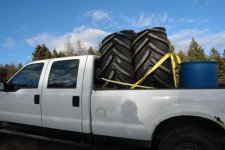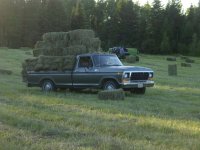boggen
Elite Member
- Joined
- Feb 22, 2011
- Messages
- 3,829
- Location
- Trivoli, IL
- Tractor
- SSTT (Sideways Snake Tain Tractor) and STB (sideways train box) tractor, dirt harvester
*wishes he could take his statement back about cost*
i would honestly see about "freight shipping" the 555c loader/backhoe. cost like 175 bucks for delivery. and that was about 200 to 250 miles away.
and if it is bran new. about only thing that could go wrong, is if not all the parts arrive. maybe some bolts/nuts. at worst pto shaft, and support frame bars. (but) going to assume for most part fully assembled if at a dealers. exception PTO shaft between deck and tractor is loose and tie wrapped on.
why tear yourself up. or less you are one of those folks, that like taking a weekend trip.
a dealer, should be able to even setup the freight shipping for you / to you. and if you do not have a way to unload it, (no tractor at the homestead) the freight company could have a lift or something on it. ((little extra charge for it)) and it won't matter to you what they use to bring it. it is left up to the shipping company. of if they use a flat bed pickup truck, or a trailer, or a semi even. if it gets damaged in shipping, it is the shipping company fault.
=================
i haven't seen much mention in your thread about various fines and like. and i don't think there is much.
the exception being if it hangs out back of vehicle past i want to say 3 or 4 feet, you need a "red flag" much like lumber hauling, and most large hardware stores have the string / stapler / red plastic flag some were easy to get to and put on.
if it hangs over the side some of the truck, i would make sure it hangs over the passenger side. that way ya not side swiping on coming traffic. and only time you would realy need to worry about is if on highway with 2 or more lanes. and ya pass someone.
as far as if your truck can handle it or not. double check "owners manual" there should be a rating in it, in how many lbs it can handle safely. if ya get caught going over manufacturers specs via police, then it might be a fine? *don't know*
i say owners manual, due to springs, shocks, tires, frame, center of gravity so your front tires not coming off the ground. and most likely owner manual should have some sort of statement.
if ya going to tie it down. i would bring some extra straps. X across it. then one towards cab. and one towards tail gate. and perhaps one to wrap around end of it. so it can not slide out of the bed of truck. might be over kill. but if ya not use to hauling. and you don't get it in a good spot (meaning) when ya hit bumps it shifts a little. it may help keep things tight enough, and keep it from falling out. just make sure the initial few miles (10 miles or so) after loading it. and each pit stop either for gas or food or bathroom break. double check all your straps.
i would honestly see about "freight shipping" the 555c loader/backhoe. cost like 175 bucks for delivery. and that was about 200 to 250 miles away.
and if it is bran new. about only thing that could go wrong, is if not all the parts arrive. maybe some bolts/nuts. at worst pto shaft, and support frame bars. (but) going to assume for most part fully assembled if at a dealers. exception PTO shaft between deck and tractor is loose and tie wrapped on.
why tear yourself up. or less you are one of those folks, that like taking a weekend trip.
a dealer, should be able to even setup the freight shipping for you / to you. and if you do not have a way to unload it, (no tractor at the homestead) the freight company could have a lift or something on it. ((little extra charge for it)) and it won't matter to you what they use to bring it. it is left up to the shipping company. of if they use a flat bed pickup truck, or a trailer, or a semi even. if it gets damaged in shipping, it is the shipping company fault.
=================
i haven't seen much mention in your thread about various fines and like. and i don't think there is much.
the exception being if it hangs out back of vehicle past i want to say 3 or 4 feet, you need a "red flag" much like lumber hauling, and most large hardware stores have the string / stapler / red plastic flag some were easy to get to and put on.
if it hangs over the side some of the truck, i would make sure it hangs over the passenger side. that way ya not side swiping on coming traffic. and only time you would realy need to worry about is if on highway with 2 or more lanes. and ya pass someone.
as far as if your truck can handle it or not. double check "owners manual" there should be a rating in it, in how many lbs it can handle safely. if ya get caught going over manufacturers specs via police, then it might be a fine? *don't know*
i say owners manual, due to springs, shocks, tires, frame, center of gravity so your front tires not coming off the ground. and most likely owner manual should have some sort of statement.
if ya going to tie it down. i would bring some extra straps. X across it. then one towards cab. and one towards tail gate. and perhaps one to wrap around end of it. so it can not slide out of the bed of truck. might be over kill. but if ya not use to hauling. and you don't get it in a good spot (meaning) when ya hit bumps it shifts a little. it may help keep things tight enough, and keep it from falling out. just make sure the initial few miles (10 miles or so) after loading it. and each pit stop either for gas or food or bathroom break. double check all your straps.

